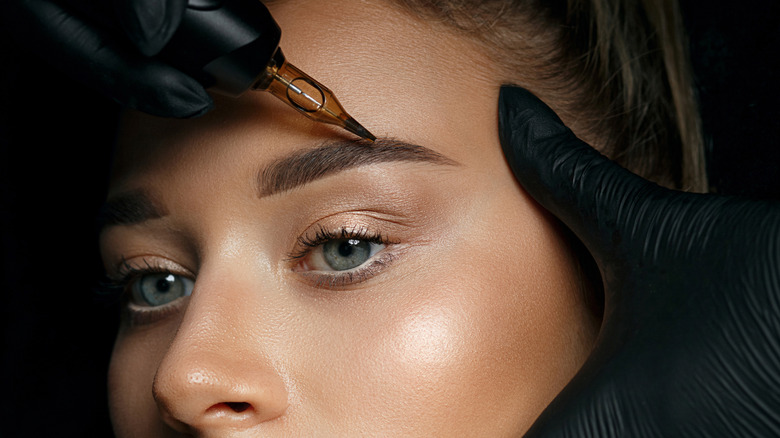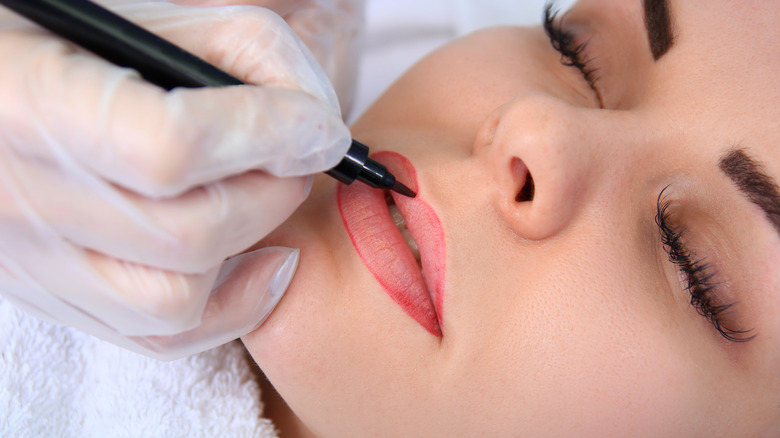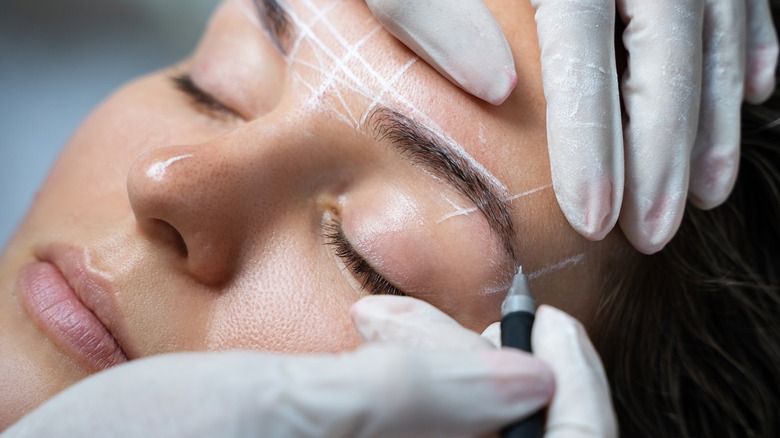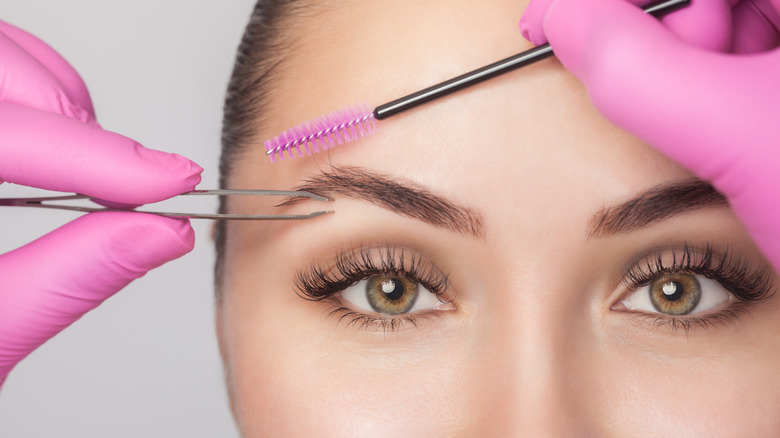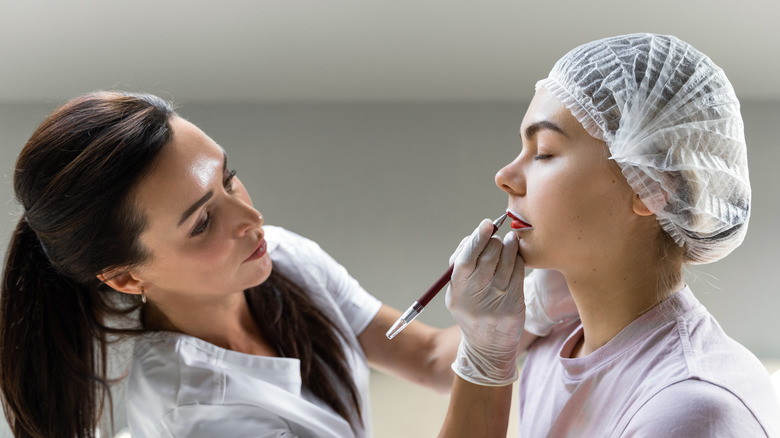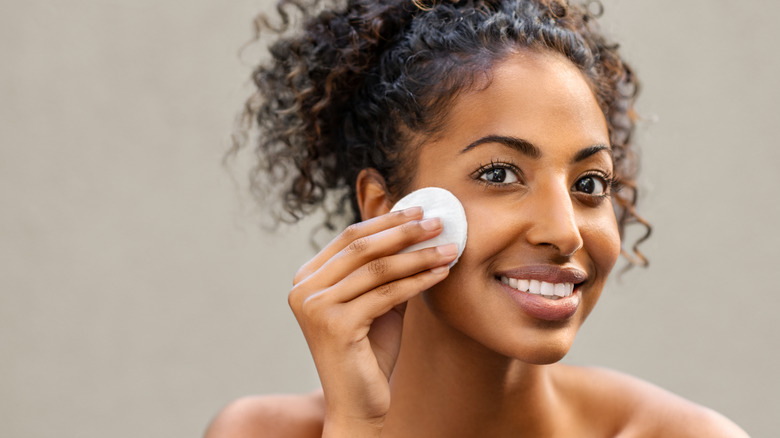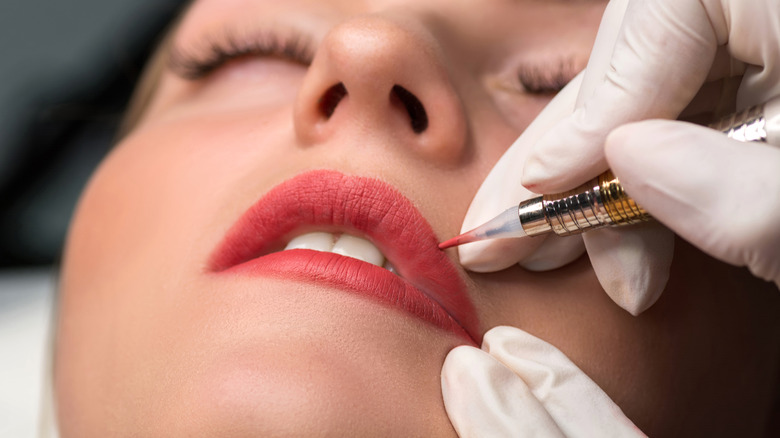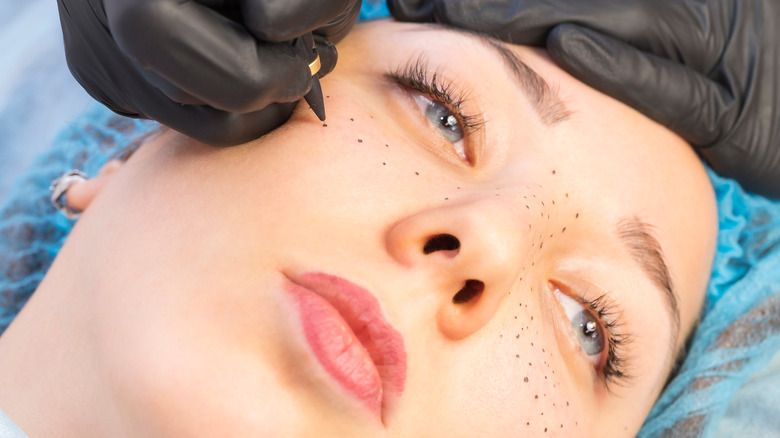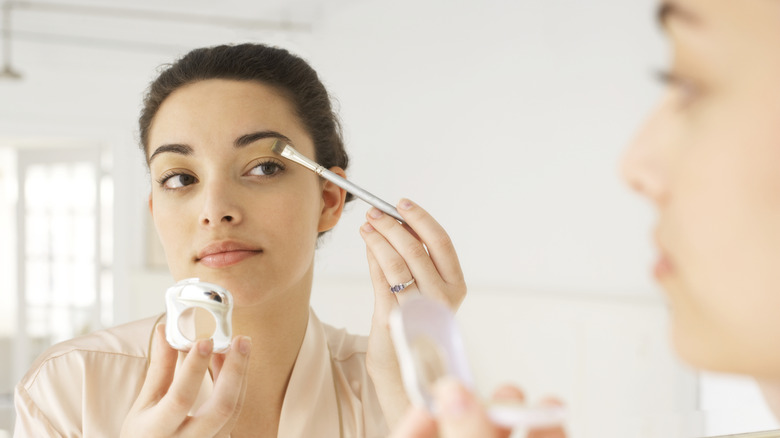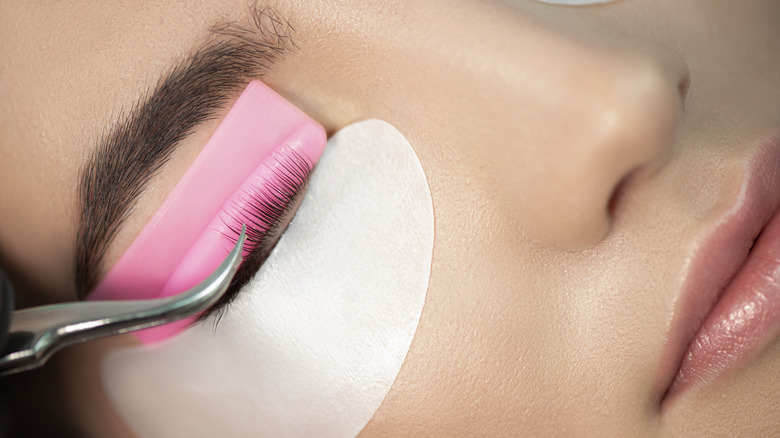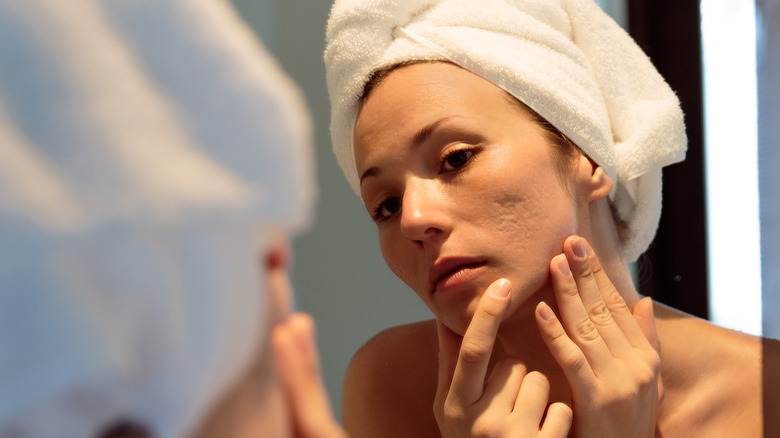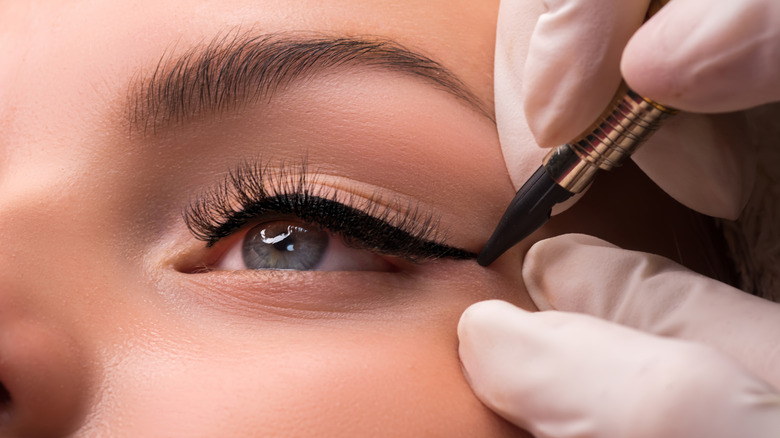What You Need To Know Before Getting Permanent Makeup
Ever watched a film and wished you had the superpower of the lead star to roll out of bed every morning with a full face of glam? What about all the times you were too lazy to remove your makeup after an absolute knockout of a night? Or the days you were running late and wished your makeup would magically do itself? The art of micro-pigmentation has turned all these surreal what-ifs into reality. With the competence of traditional body tattoos, permanent makeup has expanded the scope of beauty by cosmetically enhancing people's desired features. Per Huntington Academy, one of its earliest records dates back to the early 20th century, when it was employed as a practice to boost the natural blush of cheeks by a tattoo artist in London.
Permanent makeup intends to aestheticize the human face by upgrading its best parts, in a manner of speaking — whether you consider that part to be your eyes that just need lining or your cheeks that are only missing a few sweet freckles. Even though it isn't as eternal as it claims to be, permanent makeup warrants careful discretion before you get it done. Because as dermatologist Dr. Shilpi Khetarpal puts it, "when it comes to the face you put forward each day to the world, you want to make sure you've fully and carefully considered the commitment you're really making" (via Cleveland Clinic). So before you go ahead and book yourself a session, scroll through this permanent makeup checklist.
What exactly is permanent makeup?
Permanent makeup is a state-of-the-art innovation that is bringing beauty enthusiasts' fantasies come to life. For all those times that you pulled off a perfect winged eye that you ultimately had to remove at the end of the night, permanent makeup is the answer you were looking for. As the name explains, it's a process that makes your favorite makeup looks last through cosmetic tattooing. From dotting a face with freckles to making eyebrows appear lusher, permanent makeup is helping people achieve the face of their wildest dreams. As brow magician Melissa Pruett puts it, "Permanent makeup has come a long way since your grandma tattooed her brows on" (via Allure). The foundational idea behind this modern rendition of face tattoos borrows from natural or no-makeup looks spearheading viral beauty trends on social media, per StyleCaster.
Experts note that the boom in popularity for this permanent, semi-permanent procedure is apparently saving countless hours for makeup users. "With semi-permanent make-up, it limits the process to roughly once a year and offers the most natural-looking results," brow magician Kristie Streicher tells Vogue. The goal is to aspire for and attain a natural, minimalist glow that doesn't give the impression of made-up beauty. Additionally, this technique ensures that the wearer can go about their day without worrying about smearing their eyes or eating their lipstick. And as celebrity makeup artist Amy Jean points out, the industry is only growing by leaps!
On which parts of my body can I get permanent makeup done?
From eyes to lips, permanent makeup covers just about every base on the face that people usually touch up on the daily. Driven by popularity on TikTok — where most beauty trends first win approval today — microblading has emerged as one of the most sought-after permanent makeup procedures, raking in billions of views on the social media platform. The process is only minimally painful — akin to tweezing your eyebrows — and the cosmetic change allows for your eyebrows to take on a thicker shape that will last you for a good couple of years. "Some like the idea of perfecting their base look with permanent makeup and then building with topical makeup for a more glamorous look," permanent makeup wiz Kendra Bray says, explaining the rising craze for permanent makeup (via Byrdie).
You can go ahead and complement your new set of eyebrows with permanent eyeliner or an eyelash lift to save yourself the everyday hassle of achieving that on-fleek lash line. Lip blushing or lip tattooing is another fashionable enhancement technique, perfect for people seeking a fuller pout. The best part? "The color we use is really up to the individual," makeup guru Christopher Drummond tells Glamour. In the context of your whole face being an acceptable canvas, the market also offers permanent concealer procedures, though many experts caution against it (via Elle). Developments in the industry have also made scar camouflaging possible today.
How long does permanent makeup last?
Permanent makeup doesn't last forever. We know that's probably not what the name suggests, but compared to its daily wear counterparts, this variety of makeup does endure for much longer. Whether you opt to get your brows microbladed or your lips blushed, permanent makeup is susceptible to depreciation and will likely fade with time. Permanent makeup guru Amy Jean attributes it to "'topical' methods that allow for fading and for clients to alter the color or shape every 12 to 18 months," thanks to organic pigments over chemical inks (via Vogue). To put it simply, modern procedures involve lighter pigments that only make it to the skin's top layer, the epidermis, with the very intention of fading. The tools used to deposit these pigments also make a difference to the rate at which your makeup diminishes.
So if you're getting eyebrow tattoos, expect them to last two or three years, provided that you don't miss your routine touchups (per Allure). It's a good thing in case you want to get your eyebrows redone in a different style trending in the future. According to Estetiq International, environmental factors like steam or ultraviolet exposure also contribute to the decolorization of cosmetic tattoos. Using sunscreen and avoiding very hot showers may help prolong your makeup. Your overall health and skin type also determine the permanence of pigments on your face, with dry skin holding color better than oilier textures.
What should I expect from my permanent makeup appointment?
Prepping for permanent makeup actually begins a few days in advance of your appointment. For starters, your tattoo artist or aesthetician should be informed about any medical conditions you have, so they can determine if you are eligible to be safely inked. Pregnant and breastfeeding women are not advised to undergo permanent makeup procedures, per Dana Depta. Also, certain medications, supplements like retinol, and other cosmetic regimens like tanning or botox aren't entirely compatible with permanent makeup; consult a professional to help determine the period of time you will have to abstain from using them. During your appointment week, your makeup artist should ideally run a patch test to ascertain any risk of allergies.
"Expertise, artistry, proper care, and advanced knowledge of the skin will give the patient the lowest risk of complications," dermatologist Dr. Ava Shamban notes (via Allure). Most permanent makeup sessions take anywhere between an hour and three, depending on the procedure. Daly Beneche, pro permanent makeup artist and founder of Arch Angels NYC, explains that getting a permanent eyeliner would first require the artist to draw the desired stroke before getting down to work with "a digital machine to pixelate the pigment into the skin" (via InStyle). Tiny incisions are made where pigments are deposited, and the process is repeated a few times to set the color. Your choice of makeup could also have your artist use a bunch of needle configurations throughout the process, per Elle.
Can permanent makeup be removed?
Permanent makeup is quite ... well, permanent. Though cosmetic ink tends to fade over time, getting a stained lip or lined eye will be a significantly transformative decision. Newsflash: you won't be able to wash off this class of makeup with water. Depending on your long-term preferences, that can either be a boon or a bane. What if you wake up one day with a yearning to revert to your original, un-tattooed face? Fortunately, undoing permanent makeup is possible. One of the most popular ways to do it is via laser (per Removery). Over several sessions, the (un)desired tattoo pigment particles are targeted and broken down till they dissolve. This procedure could entail certain side effects, including an undesired darkening of the pigment.
At the forefront of the permanent makeup industry today are organic, natural-looking pigments that aren't as bold as traditional tattoos, which renders their removal a complicated process. Besides the laser, saline removal is also touted as a safe and effective solution. As explained by PMU Hub, this procedure involves injecting a saline solution in the tattoo territory, which results in scabbing of the skin (yikes!) and drying up of the pigment, causing the color to ultimately peel away. Make sure to consult your tattoo artist to pick the ideal removal procedure for your makeup. A word of caution, though, as Dr. Melanie Palm points out, "no topical treatment can remove the pigment without harming the skin" (via Allure).
Is getting permanent makeup painful?
Think of permanent makeup more as face tattoos and less as face paint. Unlike your daily wear lip liner or concealer that deposits color on your skin's surface, permanent makeup uses a more complex mechanism that involves injecting color into your skin's dermis with a needle. Naturally, that would leave you with some kind of sensation. Per Healthline, the root cause of pain stems from the needle or blade making cuts in the skin. Microblading, for instance, could give you the impression of being lightly scratched. While your threshold for pain will ultimately underscore your experience, experts contend that getting permanent makeup doesn't cause gut-wrenching pain. Makeup artist Brenda Ton has catered to clients who claim "they could sleep through the entire procedure with me" and describes eyeliner tattooing as "a slight tickle on the lashes but not much else" (via Byrdie).
That said, certain tattoo regions and techniques beget more discomfort than others. A manual makeup tool may hurt more than a sophisticated machine. Meanwhile, lip blushing could cause relatively higher pain since the mouth region is super sensitive, per micro-pigmentation magician Jackie David (via Elle). As a general rule, most establishments will anesthetize the target area with a numbing cream before getting down to work. David cautions against using numbing injections that could alter the constitution of your face. Also, avoid intake of coffee or alcohol for 24 hours before your makeup appointment to avoid compromising your pain tolerance.
What is the difference between permanent makeup and tattoos?
Permanent makeup and body tattoos share a premise — marking the skin with a desired aesthetic using color. However, these two enhancement procedures are divided by some key differences vis-a-vis the technical approach. While both artworks require the use of a needle, the distinction lies in how deep the tool goes. Permanent makeup deposits pigments in the upper layer of the dermis, which sits right below the surface of your skin (via Quantum PMU Colors). With tattoos, the ink is inserted deeper into the skin's layers. Authority Tattoo states that tattoo ink penetrates through five layers of the epidermis all the way through the dermis, where it reaches tissues that hold the pigment in place, as intended. On the contrary, permanent makeup is designed to fade — because what if, in some unforeseeable future, a no-eyeliner makeup craze captures TikTok?
The constitution of traditional tattoo ink also differs from makeup, in that it is made up of larger particles and chemicals that make skin more prone to an allergic reaction (via Killer Beauty). Permanent makeup tools and formulations take into account the sensitivity of facial skin. Everything considered, at the end of the day, permanent makeup is stacked as a subset under the broader category of body tattoos. As beauty entrepreneur Kendra Bray observes (via Allure): "Clients come in and say, 'I'd never get a body tattoo,' and in my mind, I'm like, 'You know you're tattooing your face right now."
How should I care for my permanent makeup?
Aftercare is exceptionally important to ensure longevity and quality of your permanent makeup. Keeping that glam fresh all day, every day will require you to make certain changes to your lifestyle for a while. You may feel the presence of your new enhancement on your face — scabbing, pigment darkening, and itching are typical side-effects, per InStyle — but avoid fussing around the tattooed area too much. It should take about a week for the pigments to settle naturally into your face. To help the healing process, put away your regular makeup kit for a few days until its permanent counterpart works its magic. Also, avoid public swimming pools, sun exposure, and harsh skincare products during this period, advises makeup professional Anna Kara's studio.
Broadly, there are two schools of aftercare: dry healing and wet healing. While the former traditionally instructs clients to keep their makeup dry at all times, the latter — which many experts argue is the more hygienic method — involves gentle cleansing with water and mild soap, followed by the application of reparative ointment (via Tina Davies Studio). The latter approach is said to prevent the buildup of bacteria. Though the bulk of aftercare will be in your own hands, your makeup will demand to be touched up after six weeks. Per Instyle, Ophthalmologist Dr. Glen K. Goodman suggests obtaining "a formal post-operative appointment schedule and a written description of the specific product(s) applied" from your tattoo artist.
Are there any risks involved in getting permanent makeup?
There is no watertight guarantee of permanent makeup being a 100% risk-free experience. It is generally regarded as safe, but the nature of this micro-pigmentation process makes it prone to certain inevitable hazards. Infections or allergies, for example. Makeup pigments are liable to react negatively with your face, where the skin is more sensitive than the rest of your body. While it's rare, it's not impossible (per WebMD). "Anytime you implant a foreign body into the skin, it has the potential for results not anticipated," according to Dr. Stanley Milstein of the Food and Drug Administration. As a precaution, it's always best to have your makeup artist run a test patch before your final appointment. Meanwhile, ophthalmologist Dr. Charles S. Zwerling advises people to be wary of FDA-approved pigments, warning against misrepresentation.
"Make sure they use medical-grade sterilization and high quality ink," says dermatologist Dr. Shilpi Khetarpal (via Cleveland Clinic). A word of caution: the immediate aftermath of permanent makeup procedures will likely involve some minor side effects, including bleeding or scabbing and, in some cases, even scarring. Permanent makeup essentially involves slicing open one's skin, something that the body could perceive as an injury, dermatologist Dr. Howard Sobel explains (via The Healthy). This miscommunication can lead to the development of keloids (raised scars) on the surface of your skin. In the long run, the chemicals in permanent makeup can also interfere with medical procedures like magnetic resonance imaging (MRI).
Can I get scars removed with permanent makeup?
The permanent makeup industry has made great strides in cosmetic enhancement. It's no longer restricted to traditional beautification, like the elongation of lashes or the blushing of cheeks. Modern-day requirements have compelled salons and parlors to offer new services that can also cover up aberrations, unwanted scars, or other blemishes on the body. Scar camouflage or reconstruction, as the process is called, comes under the umbrella of permanent makeup that uses pigments close to your natural skin tone to smooth over your desired target area, per Aedit. Restorative tattoo artist Nicole Johnston emphasizes that a scar should get at least a couple of years of healing time before being camouflaged with makeup: "Any type of surgery scar can be camouflaged, what matters most is how the scar healed," she says.
This procedure works best upon lighter scars, while hyper-pigmented ones like purple or blue may not respond too well. In such a case, expert recommendation posits you get a lightening laser treatment before opting for a camouflage, according to expert artist Dominique Bossavy (via Allure). People with conditions like vitiligo, those who have undergone a mastectomy, and even those with stretch marks, are known to avail of this state-of-the-art service. While camouflaging procedures have the advantage of lasting longer than other permanent face makeup, Bossavy cautions that if not done carefully with the right pigments, the restoration may backfire and actually end up highlighting the scar even more.
How much does permanent makeup cost?
Pardon the platitude, but beauty comes at a cost. Permanent makeup isn't the cheapest beautification trick in the book; it will take a few bucks to undergo this procedure. Of course, the market offers a varying price range, but since this is cosmetically life-altering (and semipermanent, if not permanent), you'll want to opt for the best services to ensure safety and authenticity. Depending on the kind of makeup you choose, you can expect to shell out anywhere between a couple of hundred dollars to an average of $2,000, with additional charges for a follow-up retouching appointment (via Greatist). The technology and pigment quality used, the surface area of the skin and expertise of the artist are all factors in determining the price point. Note that permanent makeup procedures are not likely to be covered by insurance.
Microblading, among the most popular cosmetic procedures of the lot, could typically begin at $400 in some places (via Baltic Beauty Centre) and go up to $3,000, according to Elle. Similarly, lip-blushing prices may touch $3000, though leading professionals like Jackie David and Christopher Drummond charge in the whereabouts of $1500. If you can, invest in quality services. As a woman who sought out Drummond for lip pigmentation put it (via Glamour): "A semipermanent treatment is not the time to take risks." Getting a permanent beauty mark will be relatively cheaper, while complex procedures like scar camouflage are costlier expenditures in the ballpark range of $5000.
